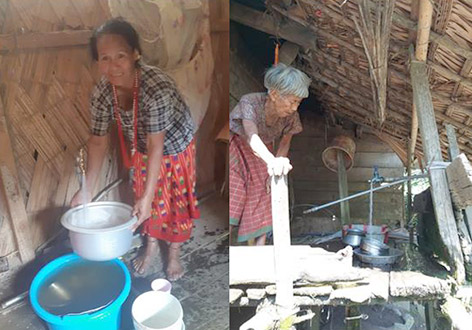 Serin, a quaint village at an altitude of 2,000 feet, nestled in the greenery of Arunachal, has all the reasons to rejoice now.
Serin, a quaint village at an altitude of 2,000 feet, nestled in the greenery of Arunachal, has all the reasons to rejoice now.
Accessing this small remote village is not an easy task. One has to trek a minimum of one day to reach Serin, which is situated in Tamen-Raga block of Kamle district.
The terrain is tough here, and so is the life of the people. The distance between Serin village and its nearest pucca road is 22 kms. The village is inhabited by the Nyishi tribe, with a total population of 130. The locals’ happiness knows no bounds as every household has a tap connection now, providing potable water in their premises.
Earlier, fetching water was a time-taking and arduous task, especially for the elderly people of Serin, as they had to fetch water from the nearby spring sources. But now, thanks to the Serin water supply scheme, tap connections are available in every household.
The Arunachal government has decided to provide 100 percent tap water connections to all the households in the state by 2023 under the Jal Jeevan Mission (JJM), the flagship programme of the government, which aims to provide safe drinking water to all.
It is the vision of the prime minister to bring improvements in the lives of the people of the country, especially the rural people. The mission aims to change the lives of the people residing in the rural areas.
In hilly areas, it is a huge burden on the women of the households to go and fetch water from a distance, which takes a heavy toll on their body. To reduce their drudgery, this mission has come as a boon and aims to provide potable water to every rural household in adequate quantity and of prescribed quality on a regular and long-term basis. The states are required to train five persons, especially women, in every village in using field test kits for testing the water supplied at the local level.
It was an uphill task to implement the Serin water supply project. Since the village is situated on top of a mountain, all the riverbed materials like sand, shingles, boulders, etc, had to be collected from the rivers located far below the village.
Besides, all the bulky materials like steel, cement, pipes, etc, had to be carried by head load from the nearest motorable road to the worksite, negotiating the tough terrains. The high operation cost of the project, compounded by unavailability of skilled labourers locally, increased the challenges manifold. But the work was meticulously planned and implemented by the PHE department.
Being a hilly state, gravity-based water supply system is used in Arunachal, which means that the force of gravity is used to move the water downhill from a source to the village. An intake structure is built to collect the water from surface sources, which is then conveyed to the village through a pipe system.
In the olden days, water treatment plants were not usually considered due to restrictive per capita cost norms. But now, with the launch of the JJM, water treatment plants are being made integral part of schemes to provide potable water of prescribed quality. Post treatment, water is collected in a clear water reservoir built above the village, from where water is distributed to FHTCs in the village by a distribution network of pipes. In order to facilitate equitable distribution of water, in larger villages, distribution tanks within the villages are provided.
Serin village is not a standalone example in the frontier state.
Dalbing village, located at an altitude of 3,300 feet in Upper Siang district, with 79 households and a population of about 380 people, is an excellent example of community mobilization. The village, belonging to the Adi tribe, is situated on a tabletop hillock. Since the JJM is a decentralized, demand-driven and community-managed water supply scheme, the natives of Dalbing made community contribution in the form of labour.
Similar works have been done in Upper Karko village, which is a border block having an international boundary. During the execution of work to provide FHTCs, the pipes and other construction materials were carried by the villagers. They also assisted the PHED in plumbing works.
Another village, Pumao, located at an altitude of about 3,900 feet in Longding district, which is the eastern most district of the state, had toilets made under the Swachh Bharat Mission, but the villagers were reluctant to use them due to unavailability of running water supply. Now they are happily using the toilets after provision of water in their households.
The implementation of the JJM in these tough terrains and high altitudes is a challenging task. Impediments increase with the harsh climatic conditions and poor connectivity. Equally challenging is to instill behavioural change in the villagers who are very reluctant to shun their beliefs and lifestyle. But the success stories of these villages are a proof of the better future envisioned by the union government to improve the lives of the people, especially the women.

